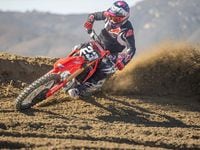Considering that Yamaha kickstarted (pardon the pun) the modern four-stroke renaissance, it is ironic that it also built the two-stroke motocrosser doing the most to hold back the four-stroke tidal wave. Yamaha's YZ250 remains endowed with a superlative combination of light weight, crisp handling and friendly big-boost performance. During Dirt Rider's comparison of 250cc-class 2003 motocross machines (Dec. '02), no other two-stroke was even close. Whenever you have a model as successful as the '03 YZ250, attempts to "fix" it risk upsetting the delicate balance of traits that first made the bike great. For '04, Yamaha certainly didn't ignore the YZ, but its engineers wisely applied the old medical command, "first, do no harm!" That thinking ensured the key upgrades are to the suspension and chassis, while the engine is virtually unchanged. Yamaha's testing guru Steve Butler answered our first questions about the engine with a succinct, "Why change?" But he then admitted, "It wasn't for lack of trying, but we never came up with anything better." We applaud their ability to resist change for the sake of change.In this case, though, the ample refinements to the suspension package and the substitution of an entirely new fork have paid off handsomely in added performance. More than enough performance to justify slipping the "old" bike into the want ads, and enough that we suspect the YZ will have few two-stroke challengers for class supremacy.Throwin' Roost!The biggest, or possibly the only, threat the '03 Yamaha YZ250 faced was the Honda CRF450R, and we already had time with Big Red before our chance with this YZ250, so we were eager. Thankfully, the YZ doesn't disappoint. All three of our testers the first day--including photo model/fast guy Danny Carlson--have spent the vast majority of their recent moto hours aboard 450cc four-strokes. In spite of that, adapting to the 250 was as easy as snuggling up to Elle MacPherson. We chose California's Perris Raceway for our introduction to the new bike--not because Perris is a garden spot, but because the track is always well-prepped and demanding. It gets some good bumps and ruts, and many of the right-out-of-corner jumps demand tractability and performance.With the sub-blast furnace temperatures of the 909 and the near-sea-level location, the jetting was a bit pingy, but a slight air screw adjustment (about seven-eighths of a turn) made the engine happy on pump gas. The Yamaha pulls so well from very low rpm that it requires very little clutch to get started or exit corners. The roll-on, or ability of the engine to respond smoothly to the throttle, is the YZ's most notable trait. Sure the bike is fast, but so are the KTM and Suzuki 250s. The YZ is almost four-stroke-like in the linear feel of its power. Turn the throttle and you get a corresponding degree of acceleration with little or no wheelspin. Very nice.Contributing to the power delivery is a pleasantly spaced and cooperative transmission that shows none of the power-on shifting crankiness of past YZ designs. And even though we had no criticism of the YZ250 clutch in '03, the '04 is vastly improved. We did have issues with the YZ450F's and especially the WR450F's clutch action. We suspect that lessons learned on the 450F earned the YZ250 two-stroke a freebie when the boys in blue applied the same techniques--employing a shorter, thinner (less friction area) cable and a more direct routing--to all the YZs.As a package, this machine is as willing and eager a performer as two-strokes come. Nevertheless, Perris' tight track prompted Editor-in-Chief Ken Faught to request a one-tooth-larger rear sprocket. Like many changes, the gearing switch was something of a trade-off, but it was a benefit on the trickiest parts of the track. Senior Editor Karel Kramer was afraid that second gear already felt too short for some out-of-turn doubles but found that the sprocket allowed the engine to pull out of corners more smoothly with less clutch control required, so the jumps were actually easier. Subsequent visits to sandier, higher-elevation Los Angeles County Raceway (LACR) and a faster private outdoor track proved the gearing change an effective choice. The outdoor track was very close to sea level, and the engine sounded tinny and prone to detonation on roll-on, but we were under one turn on the air screw, which usually signals a lean pilot. Yamaha claimed it had tried a richer pilot but with poor results. Perhaps mixing just a bit of race gas could cure the sickness. Butler felt that adding even one gallon of race fuel to four gallons of pump gas would eliminate the problem.We're definitely nitpicking here. This is, in our minds, the pinnacle of two-stroke motocross motors. In '03, the motor was wonderful--hence no changes--but there were minor chassis and suspension issues. Some riders felt that Yamaha's latest chassis design was simply too rigid and thus telegraphed too much track surface to the rider. Yamaha believed the answer was in the suspension. A bit softer rear coil and minor alterations to the rear shock made the engineers happy with the way the bike tracked and accelerated. But up front things weren't so easy. They ash-canned the entire 46mm fork and started fresh with a 48mm-legged KYB. Yamaha has remained a supporter of the KYB elastomer bottoming system, and we liked the feel of it; but Yamaha returned to a hydraulic lock to control bottoming, and the suspension improvement suggests it was the right move. The bottoming resistance is so much better that Yamaha was able to ease up the mid-stroke damping for a much plusher, more controlled ride yet still provide better bottoming control. Heavier riders will need a stiffer rear spring. The stocker worked perfectly for petite Carlson but left no bike sag for Kramer and Faught--also known as Grande and Gordo. The result was a busy-feeling front end on faster straights.We quickened the rebound on the front a bit and stiffened the compression two clicks, and were happier at Perris. For LACR, we added compression and returned the rebound to stock. So we were able to come up with fairly happy settings for riders between 155 and 200 pounds with only mini adjustments, and that was for a sandy track, intermediate-style riding and a hard clay surface. This is impressive and a big step up from '03. In our '03 shootout, many riders cited suspension harshness as the primary reason they rated the YZ second instead of first. Honda also improved its suspension, so it should be a great '04 shootout!Another strength the '03 Yamaha had was fine handling and surgical steering. The chassis geometry is unchanged, so the YZ still cuts like a knife in the turns. The steering is fine on flat ground, but it will hunt down little ruts or berms then cling like static-charged polyester. Of course, more reactive suspension only elevated these handling traits. The naturally stable chassis now goes even straighter. It is as happy in the air as ever, but now there is even less reason to fear the bike will kick or hop on chopped-up jump faces. Riders were comfortable learning new leaps, and familiar obstacles were effortless and relaxing.Perhaps the best compliment we can pay the YZ is that you don't think about it. You explore your limits without worrying about the bike's limits. Trust us, unless your limits are near Chad Reed's, you won't be held back by this bike.Opinions
I really love my '03 YZ250 so I was eager to get on the '04, and it definitely didn't disappoint me. After only a few clicks on the fork adjusters, I felt right at home on the new YZ--perhaps even more so than on my personal bike. The bottoming resistance was much better than my '03, which has stiffer springs and an increased oil level, without any added harshness at mid-stroke--definitely an overall plusher ride. The YZ250 motor is one of the main reasons I switched back to a two-stroke from a YZ426F. Picking up the front wheel out of a corner or snapping the clutch and throttle to clear an obstacle on the track is just too much fun and suits my riding style.
Thad Friday/5'11"/180 lb/IntermediateI don't think I've ever been this happy to see a company not change an engine. The YZ250 powerplant is so responsive and easy to ride that I like it for all the reasons I normally prefer to moto four-strokes. The suspension upgrades are all good, and the handling is as great as ever. If there is any two-stroke that could sate my appetite for thumpers, this is the one. I felt extremely at home jumping the bike, and the light weight is a blast. Honda's 450 is still strong competition, but the rest of the class had better bring their game face if they want to dent the YZ's reputation.
Karel Kramer/6'1"/200 lb/NoviceWhen I first sat on the '04 YZ250 it felt plush, but riding it was even more of an eye-opener. The 48mm fork is sooo much better than the '03's 46mm fork. The resistance to bottoming on big landings is great, yet it still feels plush at the top of the stroke. As a result, the front stuck really well in tight, rutted turns. The rear shock is not as big a change, but the fork makes the shock work better, so the bike hooked up through the whoops. The front brake is also a great improvement. The bike stops on a dime, and the nonslip seat holds you in place nicely without sanding your rear off. The motor is still the same, but that means commanding power all the way through. The YZ250 is a great bike for '04.
Danny Carlson/5'9"/145 lb/Pro
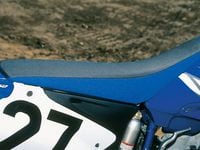
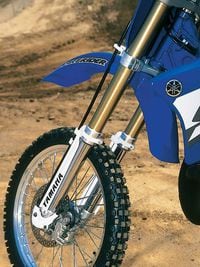
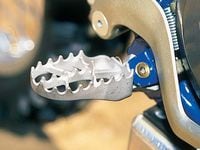

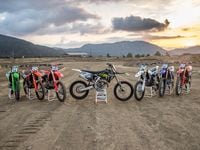




/cloudfront-us-east-1.images.arcpublishing.com/octane/3KQ6LKKNWJG5LBNYH6FKRV337A.jpg)









